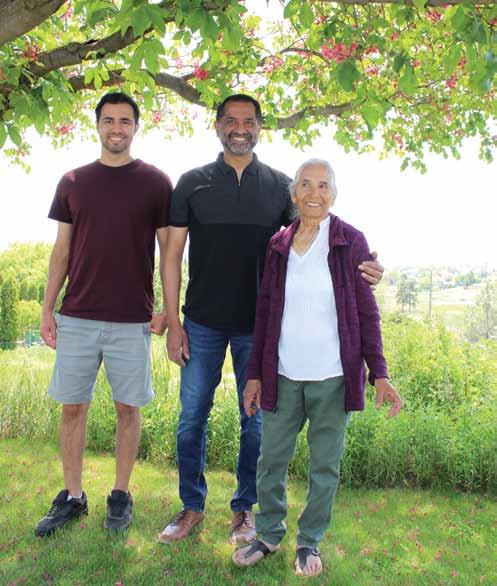
8 minute read
Farming With Heart In Westbank, BC
Okanagan Fruit Grown with Love
By Gary Symons
Advertisement
If you've ever spend a July day driving through the verdant vineyards and orchards on Elliott Road in Westbank, BC, you’ll almost certainly see a cluster of cars and people lined up at one farm in particular. They’re there to pick up the monstrous, plum-sized cherries that have been grown on this 9.5 acre family orchard by Usha Saini since 1987.
“Every summer, for many, many years, we sell the cherries in July, we put up a bit of a shade, and when they see it the people from around here all come by to get Usha’s cherries,” she says. “Last year we finished in 12 days and sold it all, and people were so happy. The cherries are massive, they grow like a plum! Ask people here and they know my name, and they’ll tell you, Usha’s cherries are awesome. We also have a bit of peaches and blueberries, and for me, it’s just great to see people happy with the food we grow.” But cherries aren’t really the family business. Rather, Usha has primarily been an apple grower for most of her life, after immigrating to Canada from her native Punjab in the 1970s, and is known among orchardists for her dedication to regenerative farming. While regenerative farming is all the buzz today, for Saini it was something she did naturally, having come from a culture where fertilizers were made on the farm, and protecting the soil was a centuries old tradition.
“For all the time I’ve farmed here, I’ve always tried to put life back into the soil,” Saini said. “From the beginning, I would take all the branches from pruning, we would cut them, and put them in between the rows. I remember my brother would complain and say the bugs will get in there over the winter and attack again in the spring, but that didn’t happen. So, I keep all my summer pruning as a fertilizer for the trees and put it back into the soil to keep it healthy.” Working on a small farm surrounded by other non-organic farms, Saini realized that organic certification would be difficult or impossible, since at least some spray would cross over onto her land. However, she tries to be “as organic as possible.” “We really wanted to keep it organic when we bought this property, but unless all your neighbours are organic too, it is very difficult,” Saini explains. “What I try to do is keep the land healthy, because if the land is healthy, the food you grow will be healthy too. I don’t use a lot of spray, just a little when it’s really needed, and I don’t use a lot of fertilizer either.”
Saini’s approach seems to work, as she and her farm were recently featured in a 2017 video about apple growers by Ambrosia Apples. Strangely enough, Usha originally didn’t want to be a farmer, even though she came from a family of orchardists, but after arriving in West Kelowna she quickly discovered that while you can take the girl out of the farm, you can’t take the farm out of the girl. “It’s funny,” says Saini, while enjoying a rare moment of relaxation in the orchard where she lives. “When I was young I never even wanted to marry a farmer, and I don’t know exactly what happened, but when I came to Canada I saw all the orchards here, and I absolutely loved it.” Rather than marry a farmer, Saini married an electrical engineer named Ram, and the couple moved to England where Ram finished his degree. When a cousin
Usha Saini, son Parm, and grandson Noah enjoy a spring day on the farm in West Kelowna.
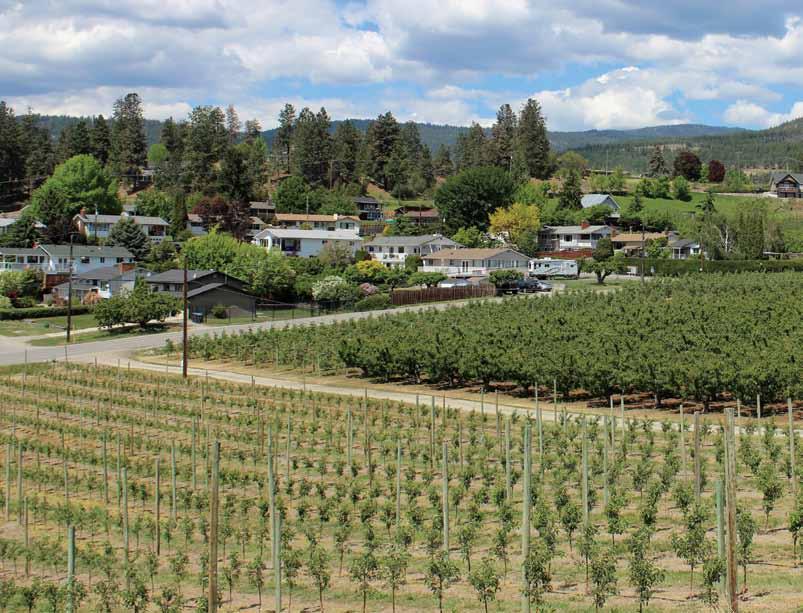
Saini Orchards in West Kelowna.
told them about Canada, Ram travelled to the Okanagan Valley to check it out, and Usha soon followed. In the beginning, the couple lived in a tiny house while Ram worked as an engineer and Saini worked at the local packing house, and occasionally worked on other people’s farms. And that’s when she regained her love of farming. When Saini saw the 9.5 acre parcel come up, already planted and with a spectacular view of Okanagan Lake, she became determined to buy the land.
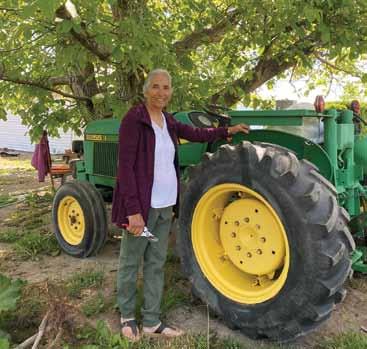
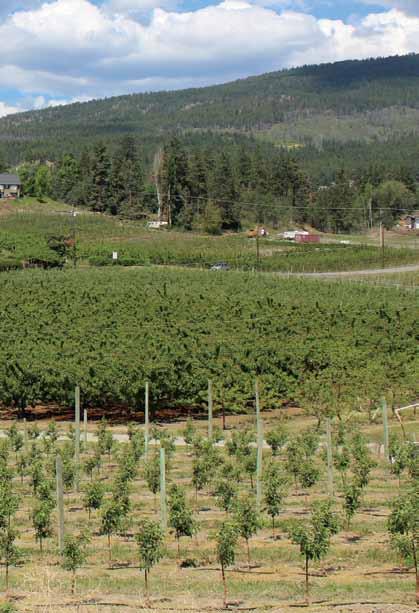
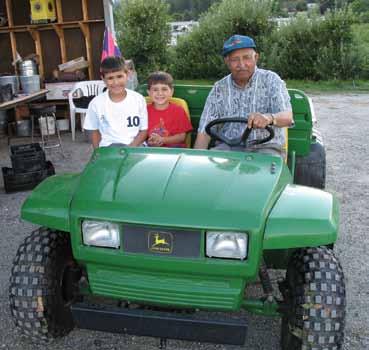
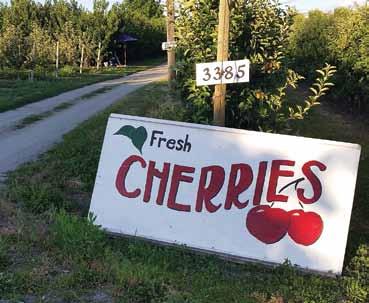
“My husband really, really did not want to be a farmer, so we had a huge argument,” Saini laughs now. “Ram said, ‘I’m not a farmer, don’t push me to do that!’, but I said, ‘Don’t you worry, I’ll do everything, just say yes to buying it. “But Ram had just had open heart surgery, and he felt so weak and frustrated, so he said, I don’t think we can do it. I said, well, if you don’t want to do this, give me my 50 per cent, and I’ll do it myself!” Needless to say, Saini won that argument, and the couple happily farmed the land for the next three decades until Ram passed away. In the beginning, however, it wasn’t easy. The trees planted on the land were not profitable, and the couple went through two replants. The first, using Summer Macs, didn’t work out, but then the Sainis planted Galas. “Ram went to visit another farmer one day,” Saini recalls. “And that man was pruning his trees that day and said, you know, take as much as you want, you’re welcome to it. So Ram took the truck and came back with all these branches, and we grafted those and it came out very nicely." Saini still runs the farm today, but has added Ambrosias to the orchard in a half and half mix with Galas, with pockets of the farm used to grow cherries, blueberries and a variety of field crops that they either eat or sell through their fruit stand. But farming alone is difficult, and after Ram’s passing Saini wondered if she could keep the farm going, before help arrived from the friends they’d made in their community. One friend named Madou comes by almost every day to help out, and Saini’s adult children make it a point to come back to the homestead every summer to work the land and help harvest the fruit.
“I’ve been very fortunate, as some very good people came into my life after my husband passed away, and they have given me a hand working on the farm,” Saini says. “I was alone, wishing I had some help, but I wasn’t asking for it, and then they just came. My friend Mahdu comes twice a day and helps out, and we’ve become real buddies. She’s now my best friend, and so I never really feel alone.”
Training Vines With Vigour
By Tom Walker
If you were an Okanagan grape grower in the late nineties and a visiting French vigneron made a comment about your vineyard, you would naturally pay attention. “We’d been growing grapes for eight years and there was a tour of owners and winemakers from France,” recalls Rod King of King Family Vineyards in Naramata. “This older gentlemen came up to me and said, you know Mr. King, this will never work, you will never be able to grow any quality.” King panicked. “I had a lot of respect for this guy, he had decades of track record,” says King. “He said to me, ‘You do know low yield is essential for high quality?’ I thought, oh god, we are in trouble.” The low yield/high quality relationship is a popular theme in grape growing. It’s something that the Kings have been able to dispel, and in turn run a profitable vineyard, following the example of successful viticulturists in New Zealand. Their training system is based on the advice of the local extension agent and a scientist from AAFC Summerland.
The low apple prices BC growers have seen for the last couple of years seem like déjà vu for the Kings. “The current poor apple prices are putting growers in the exact same position we were in back in 1992 when my brother Don and I planted our first eight acres of grapes,” King recalls. “We had looked at ways to diversify from our tree fruit business - ginseng and ostriches were all the rage - and friends in the industry urged us to try grapes.” But King wasn’t impressed when they ran the numbers through a business plan. “When we looked at the typical vertical shoot positioning training system (VSP), with a yield of 4 tons to the acre and the average wine grape prices, we would just break even. We wouldn’t be any farther ahead than with our tree fruits,” he says. King wondered if they could increase their yield to make the vineyard more profitable. The first step was to talk with provincial grape specialist John Vielvoye. “John did so much to get the grape industry on it’s feet back in the 1990’s,” says King. “He came out and looked at our site and he recognized the vigour that we had to deal with. We have very fertile soil.” Indeed, some 12-15 feet of topsoil with very high organic matter covers most of the King’s 40 acres. The dwarfing






